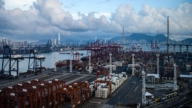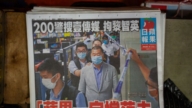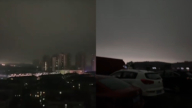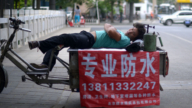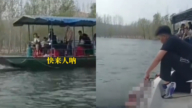【新唐人2011年8月9日讯】与香港毗邻的深圳,上个世纪50年代至70年代中共建政初期,数百万居民,由深圳越境逃往香港。“大逃港”是中共建政以来首次成功的最大规模民众维权行动。原《深圳特区报》记者,《大逃港》一书的作者陈秉安,上个月在香港揭开了百万民众大逃港的血泪史。一起来了解这段大陆民众悲惨可泣的逃港故事。
与香港毗邻的深圳宝安,早年曾经流传着这样一首民谣:“宝安只有三件宝,苍蝇、蚊子、沙井蚝。十屋九空逃香港,家里只剩老和小。”从1955年开始,深圳总共出现过4次大规模的逃港潮,参与者涉及广东、湖南、湖北、江西、广西等全国12个省、62个市 (县)。
《大逃港》作者陈秉安7月23号在香港书展,以“香港人的集体回忆─探索50至70年代的偷渡潮与逃港故事”为题,发表演讲。他表示,逃港者中有农民、城镇居民、学生、工人,甚至也包括中共军人和干部。
而中共当局对偷渡者的打击异常严厉。凡不经合法手续前往香港者,都被视为“叛国投敌”。在上世纪60年代之前,边防兵遇到不听命令的偷渡者可以随时开枪,许多偷渡者被打死在滩途上和山里。20世纪80年代初开发蛇口工业区时,一次就发现了400多具当年逃港死难者的遗骨。
陈秉安:“当时河边上是有武警,栏起来,就是荷枪实弹的,很难过去的。逃港者三条路,东边从大鹏湾海上泅水过去,大家看一看有多宽。还有鲨鱼,很多人就是被鲨鱼咬死的。有一次我问一个朋友,我说你们当时是为什么…是不是游不动死的,他说(有的)是被冷死的。”
为什么民众要冒着生命危险逃港?
陈秉安:“当时,客观上说主要是经济问题,还是一个生活困难问题,生活困难逃港的成分更多,当然也不排除其他原因,包括政治原因。再加上57年,62年,以及79年几次大的政治变化,还有经济上的困难,造成了大逃港。也不是宣传说的有政治动机的,他就是要吃饱饭、过好日子嘛。”
1959年到1961年的“三年大饥荒”,致使数千万民众死亡。1962年4、5月份,大批吃不上饭的百姓像潮水一般逃往香港。在宝安县由东至西一百多里长的公路上,外流群众成群结队,扶老携幼,如“大军南下”。据说,很多人为了到对岸吃一餐饱饭而冒死潜逃。因为当时港英政府的政策是无论如何会给逃难者饱饭吃。
1967年1月,著名音乐家、中央音乐学院院长马思聪因饱受中共凌辱,携家带口乘坐一艘小艇偷渡到香港。当时香港多家媒体进行了大幅报导。不久,一场以广州知青为主体、长达10年的逃港浪潮拉开了序幕。
1976年“文化大革命”刚刚结束,大陆民众从极端的政治高压中稍微松绑,大规模“逃港”潮再次迅猛而来。广州番禺县的沙湾大队,生产队长,党支部书记和治保主任全部外逃。惠阳县的澳头公社新村渔业大队,一共才560多人,短短几个月就有112人偷渡成功。
1979年5月6日,来自惠阳,东莞,宝安80多个乡镇的7万民众扑向深圳。宝安县政府接连发出了四道“全面禁止偷渡”令,并调派上千公安、民兵沿着海岸昼夜巡逻,在广深公路设卡,拦截偷渡人群。但还是阻止不了逃亡大军的前进。
陈秉安说,为了阻止民众外逃,中共使尽了招数。陈秉安:“第二个时段,看不行了,堵不住,老百姓还是逃,就用疏导,就作政治思想工作,唱红歌,学毛着,演红戏,忆苦思甜啊,稳定民心,有的还真是想尽了办法。(两年之后)演戏的演员、团书记全逃了。”
在百万民众一波又一波的势不可挡的大逃港浪潮冲击下,中共当局防堵无效,为了维护统治和自身利益,不得不变“堵”为“泄”,顺水推舟的对深圳先行“改革开放”政策。有人据此评论说,“大逃港”是中共建政以来首次成功的最大规模民众维权行动。
新唐人记者许旻、葛雷综合报导。
Big Fleeing to Hong Kong
In the 1950s and 1970s, at the beginning of the Chinese
Communist Party’s (CCP) reign,
millions of people fled to Hong Kong from Shenzhen.
Their fleeing was the first and the largest public
rights-defending activity since CCP founded its regime.
The author of book “Big Fleeing” (temporary translation),
Chen Bing’an, was a reporter for Shenzhen Special Zone Daily.
He revealed this tragic period of history in Hong Kong in July.
There was a famous ballad in Bao’an, Shenzhen,
a city close to Hong Kong:
“There are three treasures in Bao’an:
flies, mosquitoes, and manhole oysters;
90% of the households fled to Hong Kong,
leaving only the old and young behind.”
Since 1955, there had been four large scale flights.
Escapees were from 12 provinces and 62 cities in total.
On Hong Kong’s book fair on July 23, Chen Bing’an,
the author of “Big Fleeing” gave a speech on
“Collective Memories of Hong Kongers — illegal immigration
and stories of fleeing to Hong Kong in the 1950s~1970s.”
He said among the refugees, there were farmers, students,
urban residents, workers and even soldiers and CCP’s cadres.
The CCP government treated the escapees harshly.
If caught, they were considered traitors.
Before the 1960s, soldiers stationed at the borders were
allowed to shoot escapees disobeying their orders.
Many escapees were killed on the beach and in the mountain.
At the beginning of 1980s, more than 400 bodies were found,
when Shekou industry area was developed.
“At that time, there were armed policemen by the river to
stop people from feeing; it was hard to pass.
There were three ways to escape:
one is swimming across Dapeng Bay from the east.
You can see how broad the bay is. And there are sharks in it.
Many people were killed by sharks.
Once I asked a friend about the people died crossing the bay.
Were they drowned as they were too tired to swim?
He said that (some were) frozen to death.”
Why did people risk their lives to flee to Hong Kong?
“At that time, the main reason was economic problems.
It was hard to live.
There were also other reasons, including political ones.
Large political changes in 1957, 1962 and 1979, combined
with economic hardships led to people mass fleeing to HK.
They didn’t have political motives as the media said.
They just wanted to feed themselves and have a better life. ”
Tens of millions of people died during the three years of
the great Chinese famine from 1959 to 1961.
In April and May 1962, large groups of starving people
fled to Hong Kong as waves.
Bao’an’s main road of 50km was crowded with escapees.
People fled in groups with their old and young.
It was said that a lot of people risked their lives
just for being able to have food in Hong Kong,
as the HK government promised to provide food for refugees
without conditions.
In January 1967, musician and ex-president of
Central Conservatory of Music, Ma Sichong,
who had been abused and humiliated by the CCP,
fled to Hong Kong in a boat with his family.
Many Hong Kong media reported on this event.
Soon, a decade-long flight to Hong Kong started,
with educated youth from Guangdong as its main participants.
In 1976, just after the Culture Revolution, Chinese people
were relaxed a little from the extremely high political pressure.
A large-scale flight to Hong Kong started again.
In Shawan production team in Panyu County, Guangzhou,
the team leader, CCP secretary and security officer all fled.
In Huiyang County, out of the 566 members of a fishing team,
112 people successfully escaped within a few months.
On May 6, 1979, 70,000 people from over 80 counties
flocked to Shenzhen, from where to go to Hong Kong.
Bao’an county government issued four consecutive orders
to “fully prohibit illegal immigration.”
To stop escapees, it deployed thousands of police and militia
to patrol the coast day and night.
It also set barriers on the road between Shenzhen and
Guangzhou. However, all the methods failed.
Chen said, the CCP tried all means to stop people.
Chen, “In the second period, (they found those) not work.
People still ran away. (They) began to persuade politically
and psychologically, sing communist songs,
study Mao’s remarks, play communist performances,
recall “bad old days”, in order to reassure people.
Some of them really used all kinds of methods.
(2 years later), actors and their CCP secretary all fled.”
Challenged by waves of people fleeing,
the CCP government found them impossible to stop.
To maintain its own rule and interests,
it had to turn “stopping” to “opening”.
It implemented reforms in Shenzhen first.
Some say that the “big fleeing” was the first and the largest
public rights-defending activity since CCP came to power.
NTD reporters Xu Min and Ge Lei





